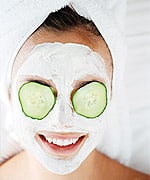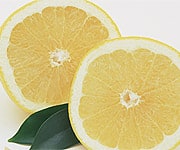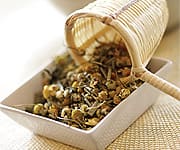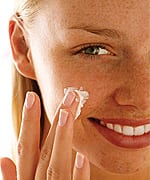Life Extension Magazine®
One of the most effective and pleasurable ways to maintain the health of your skin is through the use of skin masks targeted for specific benefits. There are a variety of nutrient-rich masks for home use that will help nourish and restore the skin’s healthy appearance. Following are some of the most advanced ingredients in today’s scientifically-based home facial masks. Ancient Traditions, Modern AdvancesThe science of natural skin care dates back as far as the 4th millennium BC. The ancient Egyptians were the first to develop natural skin care treatments based on a variety of general skin conditions. In the writings of the first century Roman historian Pliny the Elder, we even find a reference to an actual beauty regimen once used by Cleopatra herself. This recorded royal treatment began with a mask of black asphalt mud from the banks of the Dead Sea, followed by an invigorating scrub of Dead Sea salt (still used in skin care products today), and finished with a scented massage of fragrant oil to hide the pungent smell of the pitch and mineral salts. Like long ago, the science of natural skin care today still involves using botanically-sourced ingredients (such as herbs, roots, essential oils, and flowers), combining them with naturally occurring carrier agents and manufacturing them in a way that preserves the integrity of the ingredients. Unlike our ancient predecessors, who relied heavily on guesswork and mystical incantation, we now have the benefit of scientific technology that is able to verify the efficacy of new plant nutrients and assess the value of their therapeutic properties. Modern extraction techniques also provide raw materials that are extremely concentrated and free of impurities, for vastly improved results over a shorter period of time. These advancements in natural science and technology have enabled the creation of powerful, targeted formulas that specifically address certain skin conditions. Anti-Aging Mask: Restoring a Youthful AppearanceExposure to ultraviolet (UV) light from the sun, environmental toxins, stress, and other factors readily generates free radicals that can age your skin. The damage caused by these free radicals results in your collagen protein molecules breaking down and then linking back up again in a different way. This process, known as cross-linking, causes the normally mobile collagen fibers beneath your skin to become stiff and less yielding, resulting in the appearance of lines and wrinkles. Over time, free radical assault can also do damage to the sensitive lipid bilayers of your skin cell membranes, allowing them to lose water and become dry and dehydrated. Skin trauma caused by other oxidative agents also releases pro-inflammatory messengers like nuclear factor-kappa B that can destroy your skin’s elasticity and thickness.
Since ancient times and now in today’s most advanced medical spas, therapeutic masks applied to the face are used to correct many of the factors of aging. To help restore your skin’s youthful elasticity, tone, and texture, a new Anti-Aging Mask has been developed that features a unique combination of scientifically proven ingredients that not only reduce fine lines and wrinkles, but hydrate, moisturize, and protect your skin from age-accelerating free radicals. Hyaluronic AcidOne of the rejuvenating ingredients in the Anti-Aging Mask is hyaluronic acid. This large, sugar-like molecule is found in every tissue of your body. It plays a particularly significant role in your skin’s extracellular matrix, the vital jelly-like mixture which transports essential nutrients from your bloodstream, via the capillary network, to the living cells of your skin. The ability of hyaluronic acid to attract and retain 1000 times its own weight in water is unmatched by any other substance in nature. This makes hyaluronic acid absolutely crucial for maintaining your skin’s moisture and softness. Hyaluronic acid’s volumizing effect on the gel-like matrix surrounding the network of collagen fibers below your skin adds vital fullness that minimizes facial wrinkles. Although hyaluronic acid is found in great abundance in young skin, the damage caused by free radicals over time drastically depletes your hyaluronic acid reserves. Therefore, the addition of hyaluronic acid to this anti-aging formula is vital to increased cell renewal and rejuvenation, and can help restore healthy texture, color, and moisture to your aging skin.1-7 Matrixyl™Another ingredient in the Anti-Aging Mask that helps amplify the wrinkle-reducing, “plumping” action of hyaluronic acid is Matrixyl™.8,9 This synthetic amino-peptide complex effectively stimulates collagen synthesis by interacting with receptors that turn on genes responsible for cell proliferation and renewal. This patented pentapeptide significantly enhances the production of collagen and elastin within your extracellular matrix. This increased production complements the volumizing action of hyaluronic acid, thereby resulting in visibly reduced wrinkle depth, density, and number. Studies show that this patented ingredient is as effective as the vitamin A derivative retinol in reducing the signs of photoaging, yet it does not cause the skin irritation associated with retinol. ArgirelineThe argireline or (acetyl hexapeptide-3) in the Anti-Aging Mask is a relatively new, topical anti-wrinkle ingredient that reduces pre-existing wrinkle depth through a novel mechanism. This active peptide works by significantly down-regulating muscle contraction, interfering with the neurotransmitters that make your muscles contract, thereby preventing the formation of unwanted lines and wrinkles.10-12 This safe, inexpensive, and natural alternative to Botox® injections is especially beneficial for visibly reducing wrinkle depth around your eyes and forehead. Jojoba OilTo effectively lubricate dry skin, the new Anti-Aging Mask includes the outstanding moisturizing benefits of natural jojoba oil. Produced by the seeds of the jojoba plant, a shrub native to Arizona, California, and Mexico, jojoba oil’s unique chemical composition is very similar to human sebum—the oily substance secreted by the sebaceous glands of your skin that protects, moisturizes, soothes, and gives your skin its healthy glow by restoring its natural pH balance. An excellent emollient, jojoba oil is widely known for its ability to penetrate deeply and undergo quick absorption to soften dry, rough, and wrinkled skin.13 Concentrated Antioxidant Tea Blend
Finally, the concentrated antioxidant tea blend in this potent anti-aging formula contains red tea extract that is up to 50 times more effective at quenching age-accelerating free radicals than green tea, due to its high concentrations of superoxide dismutase (SOD).14-17 In addition, red tea also contains significant amounts of alpha-hydroxy acids, which not only act as natural exfoliants to remove dead skin cells, but are also healthy stimulators of collagen production and cell growth.18-21 Several other natural antioxidants derived from red tea, such as vitamin C, vitamin E, and flavonoids, help your skin repair, renew, and revitalize itself after the removal of dead skin cells.22-31 Continued use of red tea lessens the appearance of many types of skin imperfections—including fine lines and wrinkles—to give you radiant, healthier, younger-looking skin. Peel Off Cleansing Mask: Purifying and Beautifying BenefitsEven regular and careful washing with soap and water cannot remove all the makeup, dead skin cells, and other cellular debris from the surface of your skin. Over time, these accumulate, causing your skin to look dull and lifeless. In conjunction with this, sebum can collect and harden in your pores. Further, toxins from the blood and lymph fluid are expelled through your skin, where they can combine with your sebum into a pasty glue that congests your skin and blocks your pores. When the exposed tip of this plug becomes oxidized and black, the result is a blackhead (also known as a comedone). Individuals with oily and combination skin types are particularly susceptible to these problems. Ideal for people with oily or combination type skin, the new Peel Off Cleansing Mask is specifically designed to carefully lift away dull, dead cells from the surface of your skin and clarify your complexion by drawing out imbedded impurities from beneath the top layers of the epidermis. This exfoliating action allows the special herbal extracts in this rejuvenating formula to penetrate deeply into your unclogged pores to increase skin clarity and moisture. By stimulating blood circulation, this invigorating mask gives your skin a soft, healthy glow and leaves it feeling noticeably softer and smoother. Not only does this mask dramatically improve your skin’s appearance, but it also helps maximize the benefits of other skin care products you may also use for toning, hydrating, or protecting your skin. Zinc OxideZinc, an essential trace mineral found in virtually every cell of your body, is highly therapeutic because it supports your immune system and provides important antioxidant protection against damaging free radicals. Not only does zinc possess an inhibitory effect on the cells involved in inflammatory activity, it also has the ability to decrease the impact of topical toxins and other irritants on your skin.32-34 One of the major constituents of the Peel Off Cleansing Mask is a zinc oxide compound that is suspended within a polyvinyl alcohol base. As the alcohol base evaporates on your skin, a rubbery paste is formed. As the mask congeals, it imprisons dead skin cells and other debris lying on the surface of your face, while drawing out impurities trapped within your pores. Also combined in this gel-like suspension are a number of other therapeutic ingredients that effectively nourish and renew your skin. ChamomileThe healing and soothing properties of the Peel Off Cleansing Mask come from chamomile, an herbal ingredient that has been prized for thousands of years for its healing and anti-inflammatory properties. Ancient Egyptian noblewomen used a preparation containing the crushed petals of this sweet-smelling medicinal herb to soften and refresh their skin.35 The flowers of chamomile contain a flavonoid called apigenin that prevents the production of proteins which allow malignant cells to anchor to new sites, and also counters the inflammatory reactions necessary for new growths to gain blood supplies.36-38 Complementing the action of this highly bioactive compound are other constituents such as bisabolol and chamazulene which also contribute to chamomile’s potent anti-inflammatory capacity. The pronounced healing virtue of chamomile is due mainly to the highly antiseptic qualities of its phenolic derivatives that effectively neutralize certain germs and prevent infection while they relieve pore congestion and soften your skin.
Chamomile contains more than 100 active components, including essential oils, beta-carotene, tannic acid, coumarin, luteolin, thymol, boron, calcium, choline, essential fatty acids, folate, inositol, iron, magnesium, manganese, phosphorus, potassium, selenium, sulfur, zinc, B-vitamins, and vitamins A, C, E, and K. The healing, calming and soothing effect of the chamomile in this scientifically advanced formula will refresh and dramatically improve the health of your skin. Aloe VeraThe Peel Off Cleansing Mask also contains aloe vera, an ingredient highly regarded for its moisturizing and healing benefits. Used medicinally for at least 4000 years, aloe vera’s first known mention occurs in a Sumerian clay tablet written in approximately 2200 BC, where it is listed as one of the “plants of great healing power.” In fact, the amazing therapeutic properties of this succulent plant have been held in universal esteem by cultures such as the ancient Greeks and the Native Americans, who referred to it simply as “the wand of heaven.” Aloe vera is known to contain a diverse mixture of more than 70 active ingredients, including essential oils, amino acids, minerals, vitamins, enzymes, and glycoproteins that offer valuable antibiotic, astringent, pain-reducing, growth-supporting, and scar-inhibiting properties.39-42 | ||||||
CucumberPossessing the same natural pH as human skin, the cucumber extract in this Peel Off Cleansing Mask helps restore your skin’s protective acidic mantle. Composed of 90% water (which accounts for its outstanding hydrating and cooling action), cucumber extract also contains ascorbic acid (vitamin C) and caffeic acid, two antioxidants that help soothe and calm skin irritation while reducing swelling. Also contained in cucumber are a variety of other highly beneficial minerals such as silica, potassium, and magnesium. Silica is an essential component of healthy connective tissue and aids in the tightening of collagen to help reduce facial lines and wrinkles and improve your complexion.43,44 Cucumber’s hydrating, nourishing, and astringent properties contribute greatly to the overall health-promoting effects of this purifying and cleansing formula for healthier, younger-looking skin. Grapefruit
Citrus oils, such as the grapefruit extract found in this formula, have a high content of vitamin C and bioflavonoids. These powerful antioxidants neutralize the highly unstable and extremely reactive molecules that attack your cells and contribute to skin aging. In addition, studies have also shown that vitamin C helps build collagen in your skin, reducing wrinkles and enhancing your skin’s natural strength and elasticity. Grapefruit is also high in limonene, another potent antioxidant that inhibits inflammatory activity to help your skin achieve a youthful, healthy glow.45 Healing Mask: Supporting Skin RecuperationFollowing aggressive cosmetic procedures such as chemical peels, laser treatments, or microdermabrasion, the gel-based Healing Mask formula can provide fast, effective relief for irritated skin. This soothing, healing formulation is also ideal for extremely sensitive or allergic skin. The regenerative, rebalancing, and protective qualities of the Healing Mask come from its unique blend of natural ingredients that calm, soothe, and reduce redness while hydrating and moisturizing your skin. ArnicaOne notable ingredient with potent healing powers included in the Healing Mask is arnica, which contains active components called sesquiterpene lactones, known for their ability to reduce inflammation and decrease pain.46,47 Other active principals found in arnica are thymol (an essential oil), flavonoids, carotenoids, and tannins. The arnica in this preparation works by improving blood circulation to promote the healing of injured tissue. Arnica’s ability to speed wound recuperation and reduce pain, as well as its anti-bacterial and anti-inflammatory qualities, make it a valuable part of this healing formula. SqualeneObtained from natural olive oil, the squalene in the Healing Mask has a very similar chemical structure to vitamin A. The value of squalene stems directly from the fact that it is the principal hydrocarbon found in your sebum, where it amounts to approximately 12% of the total fat content.
A natural emollient that imparts suppleness to your skin without an unpleasant greasy feel, squalene readily forms emulsions with fixed oils and fat-soluble substances, yet it does not oxidize or turn rancid. Squalene is quickly absorbed into your skin, penetrating deeply to assist in the acceleration of new cell growth. It also helps to discourage the growth of microorganisms that can block normal healthy cell development by forming a protective anti-bacterial and fungicidal coating on your skin. Squalene also has a stimulatory effect on the healing process. Not only does squalene boosts your body’s natural ability to regenerate, nourish, and hydrate the skin tissue, but it is also uniquely valuable for its ability to increase the rate, depth, and penetration of other topical healing agents.48-50 Seaweed ExtractThe seaweed extract found in the Healing Mask is stimulating, revitalizing, and nourishing to your skin due to its content of iodine and sulfur, which also give it soothing, anti-inflammatory, and disinfectant abilities.51 Copper Peptide ComplexCopper’s ability to help stimulate collagen formation makes it an effective agent in the skin rejuvenation process. The copper peptide complex that is part of the Healing Mask aids healing by supporting the enzymatic function of superoxide dismutase.52-54 Corrective Clearing Mask: Balancing Acne-Prone Skin
For individuals who suffer from oily, congested, acne-prone, or blemished skin, a facial remedy is now available. The Corrective Clearing Mask features a combination of ingredients to purify your skin; remove excess oil; exfoliate and cleanse the pores; clear up blackheads; and even help prevent further breakouts. A perfect “spot treatment” for breakouts, this outstanding product contains anti-inflammatory ingredients that soothe and calm your skin, helping return it to a normal, healthy homeostasis. Zinc OxideThe zinc oxide that forms the basis of this acne treatment helps heal blemishes by reducing sebum production, eliminating toxins, accelerating healing, and relieving inflammation.32-34 SulfurWhen applied topically to your skin, the sulfur ingredient contained in the Corrective Clearing Mask interacts with the cysteine present in the outermost layer of your epidermis to form hydrogen sulfide. This hydrogen sulfide effectively breaks down the tough, keratin-containing dead skin cells that comprise this outer layer and gently removes them. In addition to this exfoliating action, sulfur also has an inhibitory effect on the growth of bacteria involved in acne, possibly from its ability to inactivate bacterial enzyme systems. Sulfur is an excellent anti-inflammatory that also effectively down-regulates the production of histamines by macrophage cells that cause infected skin to become red, swollen, and painful.55 Antioxidant Tea BlendCombined with these potent ingredients is the concentrated antioxidant tea blend, which helps reduce the production of inflammatory agents that promote new acne infections.56 ConclusionNutrient-rich facial masks offer advanced solutions for today’s most common skin problems. Using time-honored botanical extracts combined with cutting-edge nutritional agents, you can achieve a radiant, youthful complexion. | ||||
| References | ||||
| 1. Greco RM, Iocono JA, Ehrlich HP. Hyaluronic acid stimulates human fibroblast proliferation within a collagen matrix. J Cell Physiol. 1998 Dec;177(3):465-73. 2. Carruthers J, Carruthers A. Hyaluronic acid gel in skin rejuvenation. J Drugs Dermatol. 2006 Nov;5(10):959-64. 3. Price RD, Berry MG, Navsaria HA. Hyaluronic acid: the scientific and clinical evidence. J Plast Reconstr Aesthet Surg. 2007 Apr 25. 4. Born T. Hyaluronic acids. Clin Plast Surg. 2006 Oct;33(4):525-38. 5. Averbeck M, Gebhardt CA, Voigt S, et al. Differential regulation of hyaluronan metabolism in the epidermal and dermal compartments of human skin by UVB irradiation. J Invest Dermatol. 2007 Mar;127(3):687-97. 6. Lupo MP. Hyaluronic acid fillers in facial rejuvenation. Semin Cutan Med Surg. 2006 Sep;25(3):122-6. 7. Galus R, Antiszko M, Wlodarski P. Clinical applications of hyaluronic acid. Pol Merkur Lekarski. 2006 May;20(119):606-8. 8. Available at: web.winltd.com/winspa/matrixyl3000.pdf.Accessed June 6, 2007. 9. Available at: http://www.pslgroup.com/dg/2177e6.htm. Accessed June 6, 2007. 10. Available at: http://query.nytimes.com/gst/fullpage.html?res=9E02EED61239F931A15755C0A9629C8B63&sec=health. Accessed May 26, 2007. 11. Ruiz MA, Clares B, Morales ME, Cazalla S, Gallardo V. Preparation and stability of cosmetic formulations with an anti-aging peptide. J Cosmet Sci. 2007 Mar;58(2):157-71. 12. Available at: www.blackwell-synergy.com/doi/abs/10.1046/j.1467-2494.2002.00153.x?journalCode=ics. Accessed May 29, 2007. 13. Available at: http://www.drugs.com/npp/jojoba.html. Accessed May 31, 2007. 14. Available at: http://en.wikipedia.org/wiki/Rooibos. Accessed June 7, 2007. 15. Dolgachev V, Oberley LW, Huang TT, et al. A role for manganese superoxide dismutase in apoptosis after photosensitization. Biochem Biophys Res Commun. 2005 Jul 1;332(2):411-7. 16. Choung BY, Byun SJ, Suh JG, Kim TY. Extracellular superoxide dismutase tissue distribution and the patterns of superoxide dismutase mRNA expression following ultraviolet irradiation on mouse skin. Exp Dermatol. 2004 Nov;13(11):691-9. 17. Lu CY, Lee HC, Fahn HJ, Wei YH. Oxidative damage elicited by imbalance of free radical scavenging enzymes is associated with large-scale mtDNA deletions in aging human skin. Mutat Res. 1999 Jan 25;423(1-2):11-21. 18. Available at: http://www.herbs2000.com/herbs/herbs_rooibos.htm. Accessed June 7, 2007. 19. Briden ME. Alpha-hydroxyacid chemical peeling agents: case studies and rationale for safe and effective use. Cutis. 2004 Feb;73(2 Suppl):18-24. 20. Kim SJ, Won YH. The effect of glycolic acid on cultured human skin fibroblasts: cell proliferative effect and increased collagen synthesis. J Dermatol. 1998 Feb;25(2):85-9. 21. Moy LS, Murad H, Moy RL. Glycolic acid peels for the treatment of wrinkles and photoaging. J Dermatol Surg Oncol. 1993 Mar;19(3):243-6. 22. Hesseling PB, Klopper JF, van Heerden PD. The effect of rooibos tea on iron absorption. S Afr Med J. 1979 Apr 14;55(16):631-2. 23. Kucharská J, Ulicná O, Gvozdjáková A, et al. Regeneration of coenzyme Q9 redox state and inhibition of oxidative stress by Rooibos tea (Aspalathus linearis) administration in carbon tetrachloride liver damage. Physiol Res. 2004;53(5):515-21. 24. Bramati L, Minoggio M, Gardana C, Simonetti P, Mauri P, Pietta P. Quantitative characterization of flavonoid compounds in Rooibos tea (Aspalathus linearis) by LC-UV/DAD. J Agric Food Chem. 2002 Sep 25;50(20):5513-9. 25. Fitzpatrick RE, Rostan EF. Double-blind, half-face study comparing topical vitamin C and vehicle for rejuvenation of photodamage. Dermatol Surg. 2002 Mar;28(3):231-6. 26. Podda M, Grundmann-Kollmann M. Low molecular weight antioxidants and their role in skin ageing. Clin Exp Dermatol. 2001 Oct;26(7):578-82. 27. Van Robertson WB, Schwartz B. Ascorbic acid and the formation of collagen. J Biol Chem. 1953 Apr;201(2):689-96. 28. Raschke T, Koop U, Dusing HJ, et al. Topical activity of ascorbic acid: from in vitro optimization to in vivo efficacy. Skin Pharmacol Physiol. 2004 Jul;17(4):200-6. 29. Woessner JF, Gould BS. Collagen biosynthesis; tissue culture experiments to ascertain the role of ascorbic acid in collagen formation. J Biophys Biochem Cytol. 1957 Sep 25;3(5):685-95. 30. Huh CH, Seo KI, Park JY, et al. A randomized, double-blind, placebo-controlled trial of vitamin C iontophoresis in melasma. Dermatology. 2003;206(4):316-20. 31. Kuchide M, Tokuda H, Takayasu J, et al. Cancer chemopreventive effects of oral feeding alpha-tocopherol on ultraviolet light B induced photocarcinogenesis of hairless mouse. Cancer Lett. 2003 Jul 10;196(2):169-77. 32. Hoggarth A, Waring M, Alexander J, Greenwood A, Callaghan T. A controlled, three-part trial to investigate the barrier function and skin hydration properties of six skin protectants. Ostomy Wound Manage. 2005 Dec;51(12):30-42. 33. Agren MS, Soderberg TA, Reuterving CO, Hallmans G, Tengrup I. Effect of topical zinc oxide on bacterial growth and inflammation in full-thickness skin wounds in normal and diabetic rats. Eur J Surg. 1991 Feb;157(2):97-101. 34. Lansdown AB, Mirastschijski U, Stubbs N, Scanlon E, Agren MS. Zinc in wound healing: theoretical, experimental, and clinical aspects. Wound Repair Regen. 2007 Jan;15(1):2-16. 35. Available at: http://www.cancer.org/docroot/ETO/content/ETO_5_3X_Chamomile.asp?sitearea=ETO. Accessed May 31, 2007. 36. atel D, Shukla S, Gupta S. Apigenin and cancer chemoprevention: progress, potential and promise (review). Int J Oncol. 2007 Jan;30(1):233-45. 37. Lepley DM, Li B, Birt DF, Pelling JC. The chemopreventive flavonoid apigenin induces G2/M arrest in keratinocytes. Carcinogenesis. 1996 Nov;17(11):2367-75. 38. Fang J, Zhou Q, Liu LZ, et al. Apigenin inhibits tumor angiogenesis through decreasing HIF-1alpha and VEGF expression. Carcinogenesis. 2007 Apr;28(4):858-64. 39. Chithra P, Sajithlal GB, Chandrakasan G. Influence of Aloe vera on collagen characteristics in healing dermal wounds in rats. Mol Cell Biochem. 1998 Apr;181(1-2):71-6. 40. Bezakova L, Oblozinsky M, Sykorova M, Paulikova I, Kostalova D. Antilipoxygenase activity and the trace elements content of Aloe vera in relation to the therapeutical effect. Ceska Slov Farm. 2005 Jan;54(1):43-6. 41. Avijgan M. Phytotherapy: an alternative treatment for non-healing ulcers. J Wound Care. 2004 Apr;13(4):157-8. 42. Duansak D, Somboonwong J, Patumraj S. Effects of Aloe vera on leukocyte adhesion and TNF-alpha and IL-6 levels in burn wounded rats. Clin Hemorheol Microcirc. 2003;29(3-4):239-46. 43. Available at: http://www.whfoods.org/genpage.php?tname=foodspice&dbid=42. Accessed June 7, 2007. 44. Calomme MR, Vanden Berghe DA. Supplementation of calves with stabilized orthosilicic acid. Effect on the Si, Ca, Mg, and P concentrations in serum and the collagen concentration in skin and cartilage. Biol Trace Elem Res. 1997 Feb;56(2):153-65. 45. Mori M, Ikeda N, Kato Y, Minamino M, Watabe K. Inhibition of elastase activity by essential oils in vitro. J Cosmet Dermatol. 2002 Dec;1(4):183-7. 46. Seeley BM, Denton AB, Ahn MS, Maas CS. Effect of homeopathic Arnica montana on bruising in face-lifts: results of a randomized, double-blind, placebo-controlled clinical trial. Arch Facial Plast Surg. 2006 Jan;8(1):54-9. 47. Wagner S, Suter A, Merfort I. Skin penetration studies of Arnica preparations and of their sesquiterpene lactones. Planta Med. 2004 Oct;70(10):897-903. 48. Newmark HL. Squalene, olive oil, and cancer risk. Review and hypothesis. Ann NY Acad Sci. 1999;889:193-203. 49. Kelly GS. Squalene and its potential clinical uses. Altern Med Rev. 1999 Feb;4(1):29-36. 50. Murakoshi M, Nishino H, Tokuda H, et al. Inhibition by squalene of the tumor-promoting activity of 12-O-tetradecanoylphorbol-13-acetate in mouse-skin carcinogenesis. Int J Cancer. 1992 Dec 2;52(6):950-2. 51. Available at: http://www.nlm.nih.gov/medlineplus/druginfo/natural/patient-bladderwrack.html. Accessed June 7, 2007. 52. Available at: http://www.webmd.com/solutions/sc/skin-care/skin-science. Accessed May 31, 2007. 53. Available at: http://www.doctorgoodskin.com/pd/copperpeptide/. Accessed May 31, 2007. 54. Lupo MP. Cosmeceutical peptides. Dermatol Surg. 2005 Jul;31(7 Pt 2):832-6. 55. Available at: http://findarticles.com/p/articles/mi_m0PDG/is_4_3/ai_n12417035. Accessed May 31, 2007. 56. Kunishiro K, Tai A, Yamamoto I. Effects of rooibos tea extract on antigen-specific antibody production and cytokine generation in vitro and in vivo. Biosci Biotechnol Biochem. 2001 Oct;65(10):2137-45. |







